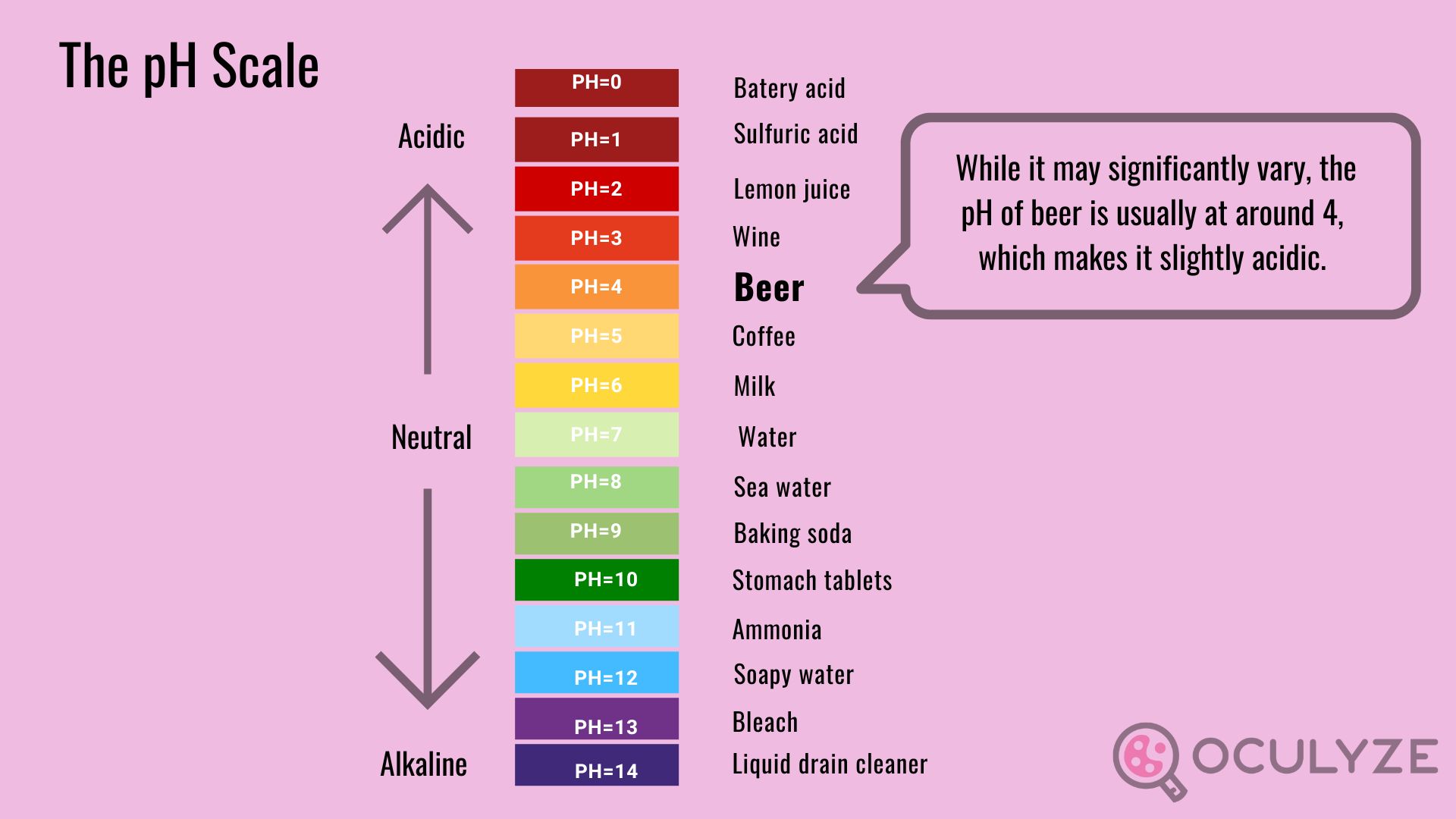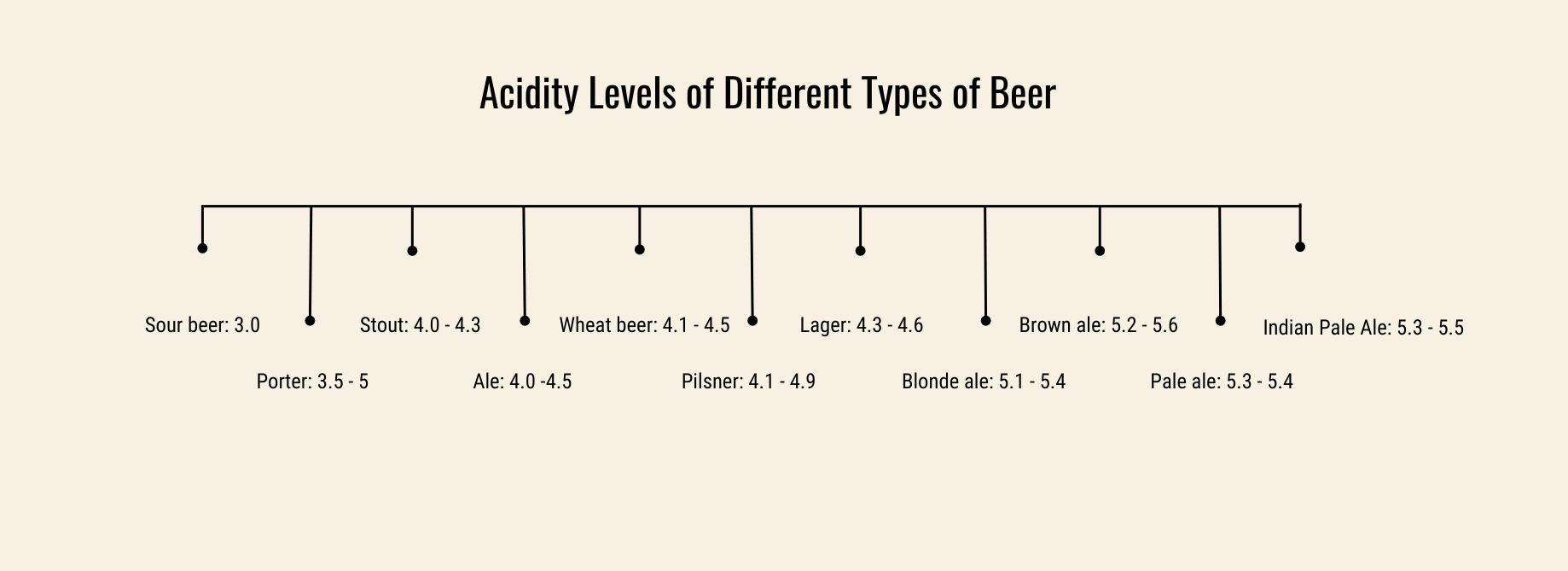The Beer Acidity Chart
There are a few different ways to understand beer acidity and, as a consequence, to design a beer acidity chart: there’s the comparison to other drinks, there’s where beer stands on the standard pH scale and, of course, there’s the matter of different beers having different levels of acidity.
This article explores them all.
Beer acidity chart: beer on the pH scale
In chemistry, the pH denotes the “potential of hydrogen” and the pH scale is used to indicate the acidity or basicity (aka alkalinity) of different solutions. The pH scale ranges from 0 to 14, with 7 being the neutral value, which is typically the value of pure water. From there on, solutions with a pH under 7 are considered acidic, while solutions with a pH higher than 7 are considered alkaline. The closest to 0, the more acidic a solution is, and the closest to 14, the more alkaline it is.
Now, because there are so many different styles of beer – that undergo different fermentation processes, are fermented by different types of yeast (and sometimes bacteria), and contain different types of ingredients – it is difficult to say, generically, where beer stands on the pH scale.
However, it is usually accepted that, on average, beer has a pH of 4, which makes it slightly acidic. About what exactly makes beer an acidic drink, you can read in detail in this article.

Beer acidity chart: beer in comparison to other common drinks
The chart above should be useful to also at least partially answer the question of where beer stands in comparison to other common drinks. Beer is usually more acidic than coffee, milk, and, of course, water, but it’s more alkaline than wine.
To compare it to other popular alcoholic drinks, beer has about the same acidity as whisky (which is normally placed at a 4) and it’s more acidic than tequila (which is a 5) but less acidic than brandies, which usually have a pH of about 3.5.
How about nonalcoholic drinks? Well, coke, for instance, is reported to have an acidity of 2.6-2.7, so it’s far more acidic than any beer out there. Most beers are also less acidic than orange juice, which has a pH of roughly 3.5, depending on the variety of the fruit.
Beer acidity chart: the acidity of different types of beer
There is a wide variety of factors that influence the level of acidity in beer, from the fermentation method to the ingredients used, and that explains why the pH of beer can range from as low as 3, to as high as 5.5. Typically, lagers will be less acidic than ales, due to the longer fermentation times, and, as a rule of thumb, the least acidic beers usually have a darker color tone.
In the chart below you’ll find the most common beer styles and where they range in comparison to each other.

As a brewer, you’ll want to control the acidity of your beer from the very first stages of the fermentation and up until the whole process has been finalized. Depending on the type of beer you’re brewing, this will vary significantly, though, and you’ll have to adapt.
Ultimately, as with everything else, it all comes down to experimenting with small batches, constantly improving your processes, and keeping an open mind to new flavors.
Cheers!
Are you still pitching fresh yeast every time? By reusing your yeast, you can save up to hundreds of thousands of dollars per year on just yeast alone!
Join the hundreds of brewers from all around the world using the Smartest Automated Yeast Cell Counter! Request a Free Demo Account today and experience firsthand how Oculyze can take your brewery to the next level!
Sources:
- https://www.researchgate.net/figure/The-pH-colour-alcohol-and-CO-2-content-in-beers_tbl1_281897222
- https://onlinelibrary.wiley.com/doi/10.1002/jib.49
- https://atlas-scientific.com/blog/ph-of-beer/
Stay on top on important fermentation insights – subscribe to our monthly newsletter and receive a hand-picked selection of our most relevant articles straight to your inbox.
Never miss a beat and get real time updates with a new article each workday by subscribing our social media channels.
Instagram | Facebook | Twitter | YouTube


